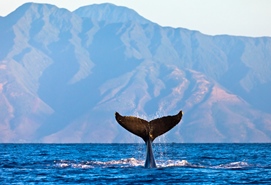
As the seasons change, so do the rankings of top travel destinations. So says Travel Leaders Group in its most recent nationwide survey of travel agents.
For the first time, the top rankings for domestic and international bookings belong to Maui, Hawaii and London. The 1,100-plus travel agency reps name the top destinations they are reserving for the remainder of the year. Results are based on actual booking data.
Two items in the news at various times during the year – Zika and the Brexit vote – may be contributing factors.
“The ‘Brexit’ vote and resulting fluctuation in the British pound has been incredibly favorable for American travelers, whether for leisure or business trips. While London has always been among the top international destinations on our list, this is further proof that travelers are very willing to adjust and seize upon a prime opportunity when there’s increased value in a particular destination,” states Travel Leaders Group CEO Ninan Chacko.
“Domestically, Maui has long been among the most sought after destinations for American travelers, but had never surpassed Orlando, Las Vegas or New York City for the top spot. Because the Zika virus has had an impact on some individuals’ travel decisions, particularly those who are pregnant, Maui’s positioning has been bolstered by having no cases of locally-transmitted Zika.”
The rankings:
Domestic
1. Maui, 34.1%
2. Orlando, 32.4%
3. New York City, 30.5%
4. Las Vegas, 28.0%
5. Cruise – Alaska, 25.5%
6. Los Angeles, 19.6%
7. Honolulu, 18.8%
8. San Francisco, 17.2%
9. Chicago, 14.2%
10. Washington, D.C., 12.4%
International
1. London, 31.0%
2. Cruise – Caribbean, 30.1%
3. Cancun, 29.1%
4. Rome, 23.2%
5. Paris, 17.7%
6. Cruise – Europe (river), 17.5%
7. Punta Cana, Dominican Republic, 17.5%
8. Cruise – Europe (Mediterranean), 13.6%
9. Montego Bay, Jamaica, 10.8%
10. Florence/Tuscany, Italy, 10.0%
Seventy-nine percent of agents said booking were higher or on par with last year at this time and more than 72% were optimistic about their business for the remainder of the year.

 Over 8 million New York City residents and its myriad visitors are getting a major awakening today — and it doesn’t involve New York Jets coach Rex Ryan verbally assaulting anyone. (Hooray!) Today, they’ll be privy to what Hoosiers have been enjoying for decades — the wonders of a
Over 8 million New York City residents and its myriad visitors are getting a major awakening today — and it doesn’t involve New York Jets coach Rex Ryan verbally assaulting anyone. (Hooray!) Today, they’ll be privy to what Hoosiers have been enjoying for decades — the wonders of a  If you’ve even visited New York City, you know the cost of living is more than a smidge higher than anything you’ll find in Indiana. Part of that, of course, is because of taxes. But even outside of Manhattan, a lack of jobs is pushing residents of the suburbs — and upstate — to other parts of the country. According to a recent poll, many New Yorkers under 30 plan to flee the state soon. Here’s the report from the
If you’ve even visited New York City, you know the cost of living is more than a smidge higher than anything you’ll find in Indiana. Part of that, of course, is because of taxes. But even outside of Manhattan, a lack of jobs is pushing residents of the suburbs — and upstate — to other parts of the country. According to a recent poll, many New Yorkers under 30 plan to flee the state soon. Here’s the report from the  New York City Mayor Michael Bloomberg has tackled some tough issues during his tenure, but now he’s seriously considering taking on the city’s traffic problem, according to
New York City Mayor Michael Bloomberg has tackled some tough issues during his tenure, but now he’s seriously considering taking on the city’s traffic problem, according to